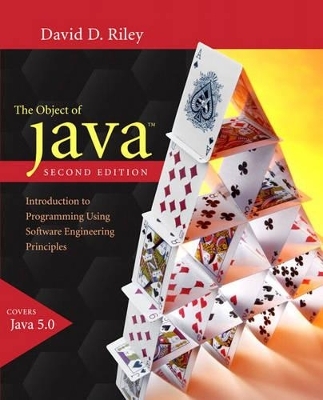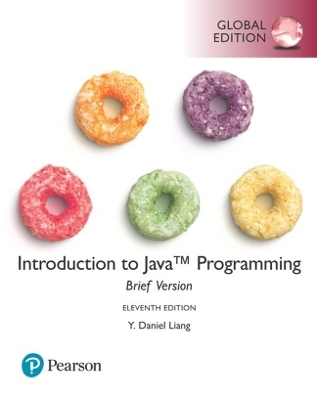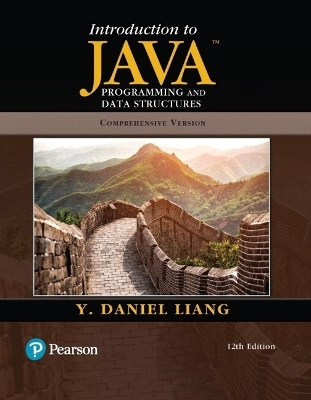
The Object of Java
Pearson
978-0-321-33158-8 (ISBN)
- Titel ist leider vergriffen;
keine Neuauflage - Artikel merken
This book takes an objects first approach, and also focuses on the skills and discipline of software engineering that are needed for good programming. Since specifications are critical for conveying code behavior in the object-oriented model, discussions of method preconditions and postconditions, and class invariants are used consistently to document examples and to define example classes. It also uses the notion of patterns to identify numerous expressions, instructions, algorithms and designs that serve to pattern program segments.
Contents Preface
Preface for the Student
Chapter 1 - Objects and Classes
1.1 Objects Everywhere
1.2 Objects in Software
1.3 Anatomy of a Software Class
1.4 The Difference between Objects and Classes
1.5 Edit, Compile, and Run
1.6 Introduction to Software Engineering
1.7 A Sample of Object-Oriented Software Development
Chapter 2 - Introduction to Java Objects
2.1 Syntax Diagrams
2.2 The Method Call
2.3 Instruction Sequences
2.4 Constructing and Assigning Objects
2.5 Coding Patterns and Swapping
2.6 Putting It Together in a Java Class
2.7 Programming by Contract
2.8 Comments
2.9 Observing Execution
2.10 Refining Algorithms–Divide and Conquer
2.11 Selecting Identifiers
2.12 A Second Example of Refinement
2.13 Calling Methods with Parameters
Chapter 3 - Introduction to Design and Implementation
3.1 Introduction to Standard Classes
3.2 Import Declarations
3.3 javax.swing.JFrame
3.4 java.awt.Label
3.5 Nonstandard Classes (Rectangle, Oval, and Line)
3.6 Prototyping
3.7 Debugging: Commenting Out Code and Using System.out.println
Chapter 4 - Methods
4.1 The Need for a Subprogram
4.2 Private Parameterless Methods
4.3 Using Parameters
4.4 Local Variables
4.5 Non-Void Methods
4.6 Standard Non-Void Methods
4.7 Introduction to Event Handling
4.8 Postcondition Notation
4.9 java.awt.Container–A Design Example
Chapter 5 - Primitive Data
5.1 Primitive Types
5.2 Primitive Integer Data Types
5.3 Differences between Primitives and References
5.4 Real Numbers (float and double Types)
5.5 System.out.println Revisited
5.6 Mixed Type Numeric Expressions
5.7 Primitive Methods (Including Math)
5.8 Constants (final)
5.9 Numeric Expression Patterns
5.10 char Data Type
5.11 Design Example–Dynamic Histogram
Chapter 6 - Supplier Classes
6.1 Clients and Suppliers in Software
6.2 Another Client
6.3 Suppliers
6.4 Scope and Lifetime
6.5 Class Interface Design Principles
6.6 Separating Read and Write Access
6.7 Method Overloading
6.8 this
6.9 Enumerated Data Types
6.10 String
6.11 JTextField (Optional)
Chapter 7 - Logic and Selection
7.1 The if instruction
7.2 Relational Expressions
7.3 Boolean Expressions
7.4 Conditional Evaluation
7.5 Predicates
7.6 The Use of implies
7.7 Nesting if Instructions
7.8 Multiway Selection
7.9 The switch Instruction
7.10 Software Testing
7.11 Logic and Programming (Optional)
7.12 Assertions Revisited
Chapter 8 - Inheritance
8.1 Extends
8.2 Class Relations: contains_a and is_a
8.3 Specialization and Extension–javax.swing.JComponent
8.4 Protected Scope
8.5 Inheriting for Event Handling
8.6 Animating by Inheriting EventTimer (Optional)
8.7 Design Example with Sliders and Text Fields (Optional)
8.8 Summary
Chapter 9 - Polymorphism
9.1 Inheritance Hierarchies
9.2 Type Conformance
9.3 Subtype Polymorphism
9.4 Abstract Classes
9.5 The Object Class
9.6 Equality by Content and by Identity
9.7 Using Interfaces
Chapter 10 - Repetition
10.1 The while Loop
10.2 Counting Loops
10.3 Sentinel Loops
10.4 Loop Design Cautions
10.5 Nested Loops
10.6 The do Loop
10.7 The for Loop
10.8 Loop Invariants
10.9 Looping and Event Handling
10.10 Testing and Loops
Chapter 11 - Containers
11.1 Containers
11.2 Generic Containers
11.3 Wrapper Classes and Autoboxing/Unboxing
11.4 Lists
11.5 List Traversal
11.6 Linear Searching
11.7 Sorting by Insertion
11.8 Generic Sorting (Optional)
Chapter 12 - Introduction to Arrays
12.1 One-Dimensional Arrays
12.2 Keeping Indices in Bounds
12.3 Sequential Processing with for Loops
12.4 Treating Arrays in Aggregate
12.5 Tables
12.6 Arrays with Reference Items
12.7 Arrays and Objects
12.8 Sorting–the Selection Sort
12.9 Two-Dimensional Arrays
Chapter 13 - File Input and Output
13.1 Files
13.2 The Java File Class
13.3 I/O Exceptions
13.4 Input and Output
13.5 DataInputStream and DataOutputStream
13.6 Text Files
13.7 Terminal-Style I/O (Optional)
13.8 Persistent Objects (Optional)
13.9 JFileChooser (Optional)
Chapter 14 - Recursion
14.1 Recursive Definition
14.2 From Recursive Definition to Method
14.3 Recursive Methods
14.4 Recursive Execution
14.5 Recursion and Repetition
14.6 More Complicated Forms of Recursion
Chapter 15 - Applications and Applets
15.1 static Variables
15.2 static Methods
15.3 Applications
15.4 Applets
15.5 Creating Packages (Optional)
15.6 Using Packages
Appendix A Introduction to Computing Systems
Appendix B Java Syntax Diagrams
Appendix C Precedence of Java Operations
Appendix D Library Software
Appendix E UML Notation
Appendix F Programming Using Windows
Index
| Erscheint lt. Verlag | 7.10.2005 |
|---|---|
| Sprache | englisch |
| Gewicht | 1204 g |
| Themenwelt | Informatik ► Programmiersprachen / -werkzeuge ► Java |
| Mathematik / Informatik ► Informatik ► Web / Internet | |
| ISBN-10 | 0-321-33158-3 / 0321331583 |
| ISBN-13 | 978-0-321-33158-8 / 9780321331588 |
| Zustand | Neuware |
| Informationen gemäß Produktsicherheitsverordnung (GPSR) | |
| Haben Sie eine Frage zum Produkt? |
aus dem Bereich

